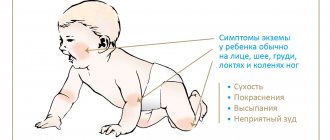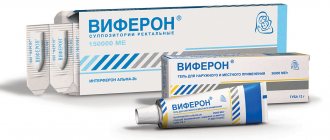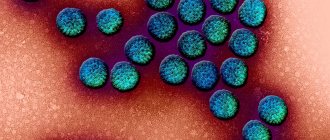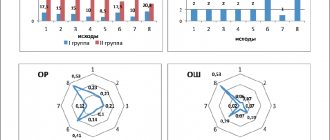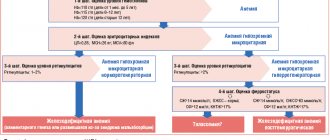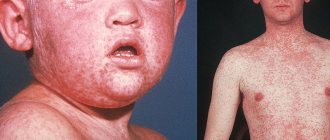Rickets is a disease of children from 2 months to 3 years. It occurs due to a lack of calcium and phosphorus in the body during the period of active growth of the child. As a result, the formation of bone tissue is disrupted - the bones soften, which is why they can become deformed and break.
Rickets often affects babies born prematurely. But minor signs of the disease also occur in full-term babies. With proper care, they disappear on their own and do not require treatment. In rare cases, insufficient bone mineralization occurs in adults. This condition is called osteomalacia.
Causes of rickets
The main cause of rickets is a lack of vitamin D, which is responsible for calcium-phosphorus metabolism in the body. It is found in minimal quantities in food, but the main share is produced in the layers of the epidermis under the influence of ultraviolet rays. Therefore, mothers are advised to take their children for walks in the fresh air more often.
Other factors also influence the absorption and delivery of nutrients to bone tissue:
- gastrointestinal disorder;
- disorders of the liver and kidneys;
- gene mutations (characteristic of hereditary forms of rickets).
Risk factors
There are also risk factors that can provoke the disease.
For the mother, these are the following factors:
- too young or mature age (pregnancy before 18 and after 40 years);
- insufficient exposure to sun and fresh air during pregnancy;
- chronic diseases;
- improper or inadequate nutrition;
- lack of physical activity;
- the interval between births is less than two years;
- third and subsequent births;
- multiple pregnancy.
The child has:
- disturbances in fetal development during gestation;
- improper organization of feeding: underfeeding, overfeeding, selection of food not according to age;
- poor absorption of formula components during artificial feeding;
- digestive problems;
- nervous system disorders.
Clinic from scratch
Rickets is an imbalance of phosphorus-calcium metabolism, in which phosphorus and calcium are not absorbed from the intestines, resulting in disruption of bone tissue formation. Most often, children experience classic rickets (D-deficiency), which develops as a result of vitamin D deficiency. As a result of this pathology, bone tissue, the nervous and endocrine systems, and internal organs are affected. The disease is associated with active growth, so the diagnosis is made in children under 2 years of age.
Rickets in newborns: vitamin D deficiency
The occurrence of rickets is associated not only with a deficiency of vitamin D from food, but also with its insufficient synthesis in the body. It is known that only 10% of vitamin D comes from food, and 90% of this vitamin is formed in the skin under the influence of ultraviolet radiation, that is, under the influence of sunlight and artificial UV irradiation. Even ten minutes of irradiation of the hands or face can provide the synthesis of vitamin D in the required amount for the body. In this regard, rickets most often develops in children born in the cold season, when the level of natural insolation is extremely low. Rickets is also common in children living in cold climates with extremely low solar activity.
Children who receive their mother's breast milk do not experience vitamin D deficiency, provided the mother is well fed. But, if the intake of proteins, fats and carbohydrates is unbalanced (for example, if a nursing mother is on a diet), the child will no longer receive the required amount of vitamin D. Also, problems with phosphorus-calcium metabolism may occur in babies receiving infant formula instead of mother's milk. When artificial feeding, calcium and phosphorus are absorbed by only 20-30%, which can affect the development of vitamin D-deficiency rickets.
Signs of vitamin D deficiency rickets
There are three stages of development of rickets: initial, peak and convalescence. The first symptoms of the initial stage may appear at 1-2 months of a child’s life, but most clearly manifest themselves at 3-4 months. The course of the disease occurs rapidly, and therefore the first stage of rickets lasts only 2-4 weeks. Symptoms of the disease at this stage are not specific, so often parents may not suspect the onset of the disease. The first stage of rickets is expressed in nervous and autonomic disorders, manifested as:
— Sleep disturbance, causeless tearfulness, frequent startling for no reason;
- Poor appetite of the baby, in which the usual dose is not eaten;
- Abnormal bowel movements, frequent constipation or diarrhea;
— Increased sweating of the child even at normal or low ambient temperatures. Severe night sweats with sweat that has a strong specific odor;
— Hair matting on the back of the head with the formation of a receding hairline;
- Slight decrease in muscle tone.
It is necessary to tell your doctor about the first symptoms, because the disease in the early stages can be stopped and not allowed to develop into the second stage - the height of which will be characterized by the following symptoms:
Pathologies of the muscular system:
— The baby has low muscle tone;
— Joint mobility develops;
— Children may develop a phenomenon called red dermographism. With this phenomenon, when you press on the baby's skin, a red color will appear. Normally, when pressed, a white mark remains.
Changes in the skeletal system:
— The bone tissue softens, and the bones of the skull become plastic. Late closure of the fontanel occurs;
— Deformation of the skull bones occurs, causing the head to take an elongated shape with a flattened occiput;
— Slow teething is noted;
— Osteogenesis occurs, during which the frontal and parietal tubercles of the skull increase, and rachitic “bracelets” and “strings of pearls”—thickenings on the phalanges of the fingers—appear;
— Due to the softening of bone tissue, deformation of the chest occurs (“compression” on the sides), a decrease in the pelvic bones, as well as curvature of the lower extremities (o-shaped or x-shaped). Flat feet develop;
Changes in the nervous system:
— Sleep disturbance, frequent tearfulness, irritability;
- Anxiety, timidity, fears;
- Heavy sweating.
Changes in the digestive system:
- Decreased appetite in the baby;
— Decreased intestinal tone and, as a result, stool disturbances (constipation or diarrhea);
— Enlargement of the liver and spleen, the baby has bloating.
With the development of rickets, disruptions occur in the functioning of the cardiovascular system and lungs, which causes difficulty breathing and tachycardia. Children have a lag in mental and physical development. In some cases, physical skills are delayed, and the child cannot hold his head up, roll over on his stomach, crawl, or walk slowly.
At the third stage of the disease or convalescence after treatment, neurological symptoms disappear and the baby gradually begins to lead a normal lifestyle. But deformational changes in the child’s skeletal system remain for life. Thus, for women who suffered from rickets in childhood, a narrowing of the small pelvis is characteristic, which is an indication for a caesarean section during childbirth.
Nowadays, vitamin D deficiency rickets, detected in a timely manner in the early stages, is successfully cured, leaving no trace of itself in adult life.
Diagnosis of rickets in children
The diagnosis of rickets is determined by clinical signs, which are confirmed by laboratory tests and x-ray data.
To identify a more accurate degree of disturbance of phosphorus-calcium metabolism, a biochemical test of blood and urine is prescribed to determine the content of phosphorus, calcium and alkaline phosphatase. A urine test (Sulkowicz test) is performed to determine the level of calcium loss. In children with pathology, this indicator at its height will have a negative value. To determine the degree of bone demineralization, an x-ray of the long bones is taken.
Consequences of vitamin D deficiency rickets in children
Rickets is a serious pathology for children, so if alarming symptoms appear, you should show your baby to a doctor. Currently, modern medicine makes it possible to diagnose the disease at an early stage. If therapy begins at the first stage of the disease, the disease responds well to treatment without developing consequences in the future.
But it often happens that rickets can be detected already at the second stage of the disease, in the presence of pronounced symptoms, when serious changes are already observed in the baby’s body. The consequences of such rickets will have to be treated throughout your life.
In children who have suffered a severe form of rickets, severe skeletal deformations are observed, for example, curvature of the legs, scoliosis, and pelvic deformation. Also, such children experience some delay in neuropsychic and physical development.
The consequences of rickets will also be disruptions in the functioning of the immune system, and as a result, frequent colds turning into bronchitis and pneumonia. Often children who have had rickets suffer from dental caries. In adulthood, the consequences of rickets manifest themselves in the form of osteoporosis.
Children who have had rickets should be examined by a doctor quarterly for at least three years. A pathology such as rickets is not a contraindication to vaccination. Such children can be vaccinated within two to three weeks after the start of treatment.
Treatment of vitamin D deficiency rickets in children
The treatment of rickets requires an integrated approach. Treatment is prescribed by the doctor depending on the severity of the symptoms. Most often, hospitalization is not required, and treatment takes place at home. Typically, therapy includes organizing the correct daily routine, a balanced diet, medications and non-drug interventions. Children suffering from rickets need daily sunbathing and exposure to fresh air for three to four hours. Such babies need to undergo daily hardening procedures in the form of rubdowns and air baths.
Particular attention should be paid to the child's nutrition. If the baby is breastfed, then the nursing mother should carefully monitor her diet, receiving the required amount of vitamins and microelements. If necessary, you should take pharmacy vitamin complexes. But since breast milk contains vitamin D in small quantities, and the vitamin content in infant formula is only 400 ml/l, there is a need for additional administration of vitamin D, phosphorus and calcium. Children with vitamin D deficiency rickets need early introduction of complementary foods. Thus, vegetable puree and yolk should be introduced from 3-4 months, cottage cheese from 4 months, porridge from 4-4.5 months and meat from 5-6 months. Juices and fruit purees are also introduced at an earlier date.
The baby's diet should be balanced and contain the required amount of proteins, minerals and vitamins. Since vitamin D is a fat-soluble vitamin, it is important to monitor the balance of fats in the child’s body and promptly introduce fats, such as butter, into the baby’s diet.
Specific treatment will be carried out with vitamin D preparations. The duration of treatment and dose are determined depending on the severity of the disease. The minimum therapeutic dosage of vitamin D will be at least 3-4 thousand IU/day. The therapeutic dose of the drug will be higher than the prophylactic dose. Also, complex treatment includes taking multivitamins, calcium supplements, and fluoride. After completing the treatment course with vitamin D, a prophylactic dose is prescribed. To exclude the development of hypervitaminosis D, treatment is carried out under the control of the Sulkovich test and biochemical markers.
Non-specific treatment includes procedures aimed at general strengthening of the body: general ultraviolet irradiation, therapeutic massage, exercise therapy, pine baths to strengthen the immune system and calm the nervous system and sodium chloride baths to increase muscle tone, therapeutic mud applications and paraffin therapy.
Prevention of rickets
You should think about preventing rickets even before the baby is born. For preventive purposes, the expectant mother should take special vitamin and mineral complexes containing calcium and vitamin D, eat a healthy and balanced diet, spend time in the fresh air every day and avoid infectious diseases.
After the baby is born, the mother needs to continue taking vitamins and feed the baby with breast milk. To improve the overall health of the baby, hardening procedures should be carried out and daily massage, which plays an important role in prevention. During daily walks in the fresh air, it is necessary that the baby's skin receives a sufficient amount of sunlight. For specific prevention of rickets, a child must systematically receive vitamin D. The course prophylactic dose is prescribed by a pediatrician and is usually 200-400 thousand IU.
Rickets: symptoms
If the symptoms of rickets are not noticed early, it can lead to bone deformities and developmental delays. The first bells appear from the age of two months:
- frequent and causeless mood swings;
- restless sleep: trembling, convulsions, crying;
- lethargy and poor appetite;
- sweating and itching, especially in the scalp, resulting in hair loss on the back of the head;
- flattening of the back of the head and soft edges of the fontanelle;
- congenital hip dysplasia.
At this stage, violations can be corrected without serious consequences. In the future, the symptoms become more pronounced and dangerous:
- developmental delays: inability to hold head up, sit, stand, crawl, walk;
- short stature and slow weight gain;
- elongated skull with bumps on the forehead and crown of the head;
- rounded tubercles - “rosary beads” at the border of costochondral thickenings;
- an arched depression under the ribs called Harrison's groove;
- “bracelets” on the wrist joints;
- O and X-shaped curvature of the legs;
- convex “frog” belly;
- late teething;
- rachitic hump in babies who were seated early.
How to recognize the disease
Most external signs of rickets are not specific, i.e. they can signal different diseases. Until the age of three months, it practically does not appear, and quite distinct symptoms are formed no earlier than in the second half of the year. Parents should be wary if their child:
- becomes nervous, frightened by sharp sounds or flashes of a switched-on lamp;
- sweats profusely, and the scalp often becomes moist, sticky sweat with a sour smell irritates the skin and causes itching, the child often scratches his head;
- muscle tone is reduced, so the child is delayed in physical development - later than peers, he begins to sit, crawl and stand on his feet;
- when palpated, a large fontanel with soft edges is felt.
In severe forms of the disease, symptoms of rickets in children manifest themselves in the form of deformation of bone tissue. In a sick child:
- legs are bent, knees are turned outward or brought together;
- sunken sternum;
- flattened nape;
- The parietal and frontal tubercles protrude, bald patches appear on the forehead;
- For a long time, teeth do not erupt and the fontanel does not close.
The disease affects the activity of internal organs, which manifests itself as:
- periodic seizures;
- digestive dysfunction, stool instability, decreased weight;
- anemia;
- reduced immunity, frequent colds and respiratory infections.
The listed symptoms may indicate not only rickets, but also a number of other diseases, so laboratory tests are necessary to confirm the diagnosis.
Are you experiencing symptoms of rickets?
Only a doctor can accurately diagnose the disease. Don't delay your consultation - call
Diagnostics
Possible malfunctions that may be a sign of rickets in children should be detected by the local pediatrician during a routine examination. The doctor’s task is to prescribe vitamin D and refer the baby to see specialists. This could be a neurologist, orthopedist, gastroenterologist or endocrinologist. It all depends on the symptoms.
To make a final diagnosis, the following procedures are required:
- Blood test for calcium, phosphorus, vitamin D, creatinine, alkaline phosphatase and parathyroid hormone. Take it on an empty stomach.
- Urine analysis for calcium, phosphorus and creatinine. Take a morning portion of liquid.
- Digital x-ray of limbs and chest.
If a hereditary form of rickets is suspected, a genetic analysis is performed.
FAQ
Does rickets occur in breastfed children?
Yes, a baby whose mother is breastfeeding may develop rickets if the mother's diet or lifestyle does not provide her body with enough of this vitamin. Therefore, pediatricians prescribe vitamin D preparations prophylactically to all children, including those who are breastfed.
What are the consequences of rickets?
The most severe consequences of the disease are skeletal deformities, including:
- incorrect bite and, as a result, difficulty chewing, impaired diction, jaw deformation, caries;
- rachiocampsis;
- curvature of the pelvis, especially dangerous for girls;
- mental deficiency due to cranial deformation.
These are just some of the adverse effects. Therefore, even with minor symptoms of rickets, the child should be shown to a doctor.
Does a child need to take calcium with rickets?
The need to prescribe calcium supplements becomes clear from the results of laboratory tests. With severe hypocalcemia, the child may need pharmaceutical drugs, which must be combined with an increase in the proportion of calcium-rich foods in the diet - dairy products, legumes, almonds and pistachios.
Treatment and prevention of rickets
For the treatment and prevention of rickets, children are prescribed vitamin D: at least 1000 IU per day for infants, 1500-2000 IU for children from one to three years old. Regular walks, massage, therapeutic exercises, and exercises are also recommended. The child should be breastfed or an adapted formula, and complementary foods should be introduced in a timely manner. The diet of older children should be based on foods rich in phosphorus and calcium.
If the disease is caused by disturbances in the functioning of internal organs, then therapy is first aimed at eliminating this pathology.
It is important to understand that such measures are effective only in the early stages. If rickets is detected at the stage of skeletal deformation, it will not go away without consequences. Surgery may be required.
How is rickets treated in children?
Currently, the treatment of rickets is complex. It includes:
- organizing a daily routine with daily long walks in the fresh air;
- providing adequate nutrition that satisfies the child’s need for calcium and other minerals;
- drug therapy - taking vitamin D in a dosage sufficient to compensate for the deficiency;
- non-drug therapy - massage, therapeutic exercises, ultraviolet baths, balneotherapy.
If clinical recommendations are followed, rickets is cured quickly enough and without long-term consequences, but only if measures were taken in the initial stages of the disease. In severe forms of the disease, it is not always possible to overcome skeletal deformation; delays in physical development, as well as the negative impact of the disease on the nervous system, are not without consequences. For three years after recovery, the child remains under clinical supervision with quarterly medical examinations.
What are the consequences?
The most severe consequences are associated with changes in the shape of the skeleton, namely:
- curvature of the jaw and, as a result, difficulty chewing, malocclusion, caries and problems with diction;
- deformation of the pelvis and spine;
- mental retardation.
Rickets is a dangerous disease that can leave a mark for life. To prevent this, you need to be attentive to any changes in the child’s behavior and report them to the doctor. You can consult with a specialist and make an appointment by phone or through the online form on our clinic’s website.
FIND OUT PRICES
Preventive measures
Prevention of rickets in an infant should begin in the last months of pregnancy and should only be carried out under the supervision of a specialist.
A pregnant woman needs to eat well, walk in nature, and take vitamins in recommended doses.
It is important for the baby to provide rational feeding, going for walks, exercise and massage.
All children under three years of age are prescribed vitamin D in prophylactic doses depending on age, type of feeding and region of residence.
Victoria Druzhikina
Neurologist, Therapist
For information on the symptoms and treatment of rickets in infants, watch the video “Doctor Komarovsky’s School”:
This article has been verified by a current qualified physician, Victoria Druzhikina, and can be considered a reliable source of information for site users.
Bibliography
1. https://sevgb6.ru/doc/klinicheskie-rekomendacii/raxit.pdf
Rate how useful this article was
5 Voted by 1 person, average rating 5
Did you like the article? Save it to your wall so you don’t lose it!

